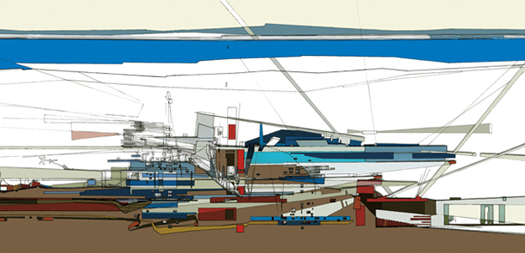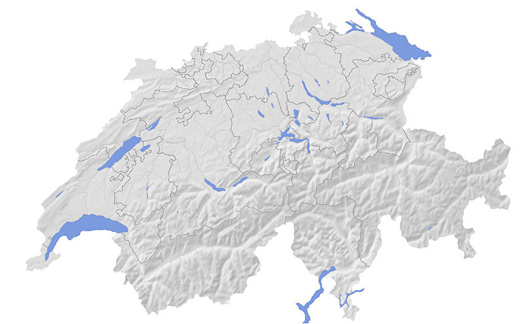The following is another contribution to the constellation of blog posts supporting the Glacier/Island/Storm Studio at Columbia University; read mammoth‘s previous Glacier/Island/Storm posts.
LANDSCAPE MACHINES
In Magic, Machines, and Architecture, published in Pidgin 6, we find a gloriously simple description of the function and nature of machines by a participant in a course at Princeton University:
“The question was bluntly provocative: Machines. What are they? What do they do? The response was just as succinct: “They translate.”
The student who gave this response, Leo Henke, explains,
“I would propose that in general, machines are mechanisms for translation between different states. A ship translates things from one place to another, a cam translates circular motion into linear motion, a mill translates the motion of a river into the motion of a grindstone. Of course machines can also translate information instead of motion for example the position of stars into geographic position. Or as [the professor] has suggested translate information through time with the study of history.”
Mammoth has already suggested that glaciers, islands and storms may be understood as events; but another way to read these events may be as geological machines translating landscape and energy. For example, Rob described glacial mechanisms:
“…the material for [glacial] deposition is acquired through the production of erosional landforms; one might be tempted to say that glaciers do not actually produce any new landforms, but only rearrange existing landforms. The primary mechanism for the formation of glacial landforms is the “action of moving ice and… the deposition of till beneath and adjacent to the glacier” (the most familiar glacial landscapes, such fjords and the aforementioned moraines are produced through this mechanism), but glaciers also produce accretions through other mechanisms, including the discharge of sediment in meltwater and the periglacial formation of “rock glaciers” (which are composed of both ice and rock fragments) — and erosions through an equal variety of secondary mechanisms…”
In other words, glaciers, through a variety of mechanisms, translate landforms from one geological language to another. Glaciers and storms translate latent gravitational or thermal energy in earthbound or airborne matter into geological scars and atmospheric accretions; volcanic islands result from the translation of energy from Earth’s mantle through its crust.
For an architect, the useful thing about understanding these events as machines is the obvious parallel it presents to how buildings are understood (“a house is a machine for living in”). If a glacier (or an island, or a storm) is a machine, and a building is a machine, then architects should be able to design buildings which act like storms (or glaciers, or islands), or tactically interact with them.
I would be remiss, at this point, if I didn’t mention Smout Allen and their extraordinary artificial landscape machines, which they term “augmented landscapes” — built structures which blur distinctions between building, landscape, and process. Their work builds on the processes extant in specific landscapes, speaking a pidgin dialect which opportunistically amplifies or diverts existing energy and matter translations.


[Image of Smout Allen’s Geofluidic Landscape, from their website. In their excellent Pamphlet Architecture, they describe the project thusly:
The passage of abundent water on the site provides a source of kinetic energy that invades the building. Trenches, gullies and reservoirs are cut into the rock to channel water throughout the gardens and through the service core. Counterbalances and weights shift building peices. The internal space and the exterior form are reconfigured, as the floors become walls, panels move to reveal new spaces, and garden beds are raised and tilted toward the sun. The water flow also provides the energy to power the building. This moving landscape requires complex control. A “computer” and its processors take the form of fluidic switches within the rock landscape at a super enlarged scale – larger enough to be viewed at a distance. The computer’s decision making processes are therefore made physical.
For bonus Smout Allen, don’t miss this interview by BLDGBLOG]
BOUNDARY MACHINES
Geoff Manaugh informs us that one student in the studio is studying architectural possibilities for a “border research station” at the Swiss-Italian border in the Alps:
“…borders between these two countries are measured by glacial mass, so the border is constantly shifting. How do you build in an internationally changing border zone like this – let alone how do you mark the border? “

[Switzerland’s Glaciers, via wikipedia]
Working forward from the contention that glaciers are as much events as objects, the thought that sovereign territories are divided in part by events instead of fixed geography is fascinating; and the notion that architects can intervene in these processes, literally shaping nations, is even more fascinating. Where islands, rivers, and glaciers delineate countries, they are typically considered to be the permanent, cauterized boundaries of a country, perhaps altered by historical events (border wars, invasions, treaties), but not in-and-of-themselves unstable. Yet this common assumption is not as true as it may seem — these landscape boundaries are equally events, equally ephemeral, even if sometimes on a different time-scale. A country is an aggregation of events, not merely in its history, but in its physicality: some fast, some slow; some as content, some as boundary; some human, some landscape.
And so an extra translation is added — from energy to matter to sovereignty. Given the socio-political consequences effected by the function of these landscape machines, it’s surprising that bizarre legal maneuverings of the sort described by Quiet Babylon aren’t far more common. It seems that territorial ambiguity is far more prevalent than the occasional diplomatic definitional scuffle — the lines are shifting right under our feet. Instead of attempting to create new land which meets standards established by international treaty, subversive nations might surreptitiously intervene in the mechanics of their existing border machines.
What are the implications for the design of embassies, which are also instances in which architects literally build new territory for a country? They are already machines, translating culture among intertwined countries. Should they become events as well, ephemeral on a different timescale? Maybe the embassy becomes a territorial fail-safe, expanding and contracting as the boundary shifts to maintain a constant relative area: instead of forts, bucky bars. Or maybe they become control nodes for an army of geofluidic border research stations, themselves powered by and moving with the glaciers, tracking and influencing the shape of nations.


“Or maybe they become control nodes for an army of geofluidic border research stations, themselves powered by and moving with the glaciers, tracking and influencing the shape of nations…”
Icelanders, jealous of the relative stability of the Swiss banking system, pay Russian hackers to introduce stealthy bugs into the computer code controlling the movements of the border stations; over time, minor fluctuations build into wild and unpredictable oscillations. Their borders literally unstable, the Swiss and the Italians prepare for war…
Off topic slightly but I just realized that to my eyes Smout Allen’s drawings and renders seem similar in style to Lebbeus Woods own drawings. All angular chaotic and tectonic/geologic. Yet, hardly buildable objects in the usual sense.
It’s probably accurate to say that you couldn’t build objects from the drawings exhibited by the firm, but I’m not sure that makes the represented objects unbuildable – just unfinanced (which is different from much of the work of Lebbeus, which often seems to be genuinely unbuildable, not that that really matters for his purposes).
[…] can’t let Stephen’s mention of Smout Allen pass — particularly in the context of a discussion of process and event in […]
Stephen good point about unbuidable vs unfinanced.
Plus as i think the later post on the “Blooming Landscape, Deep Surface” proposal makes clear they can propose a buildable object. Whereas Lebbeus’s proposals so often as you seem to be about the anti-building?
The merit in Smout Allen’s work is not about build ability it is about the treatment of the landscape as a dynamic system. Whether it be geologic, atmospheric or hydrologic all this systems are active, operating on a unique time scale. This state of flux is a constantly overlooked asset, providing potential for the architecture to augment or capitalize on a powerful resource. This idea of manipulating the boarders of a region by growing or retracting glaciers is one such example of how to take advantage of the landscape.